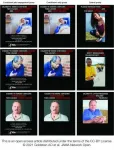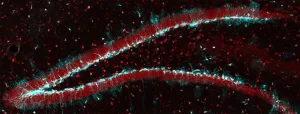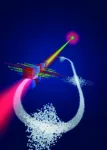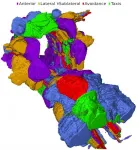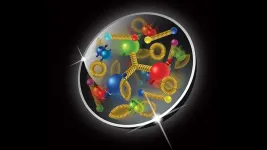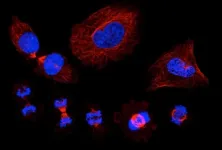(Press-News.org) CHAPEL HILL, N.C.--For the last decade, the U.S. Food and Drug Administration has required tobacco manufacturers and importers to report the levels of harmful and potentially harmful chemicals found in their tobacco products and tobacco smoke. The idea was to educate the public and ultimately to decrease tobacco use, but little research has demonstrated if such information can impact on people's decisions to quit smoking.
A new study from the University of North Carolina at Chapel Hill has found that smokers who saw messages about tobacco chemicals with associated health risks, together with graphic health images and information promoting quitting, expressed greater desire to quit smoking. In the journal JAMA Network Open, UNC Lineberger Comprehensive Cancer Center member Adam O. Goldstein, MD, MPH, professor of Family Medicine at the UNC School of Medicine, and Leah M. Ranney, PhD, associate professor of UNC School of Medicine's Department of Family Medicine, report smokers' intentions to quit smoking increased almost 10% after being exposed to the messaging.
"Communicating about toxic constituents found in combustible tobacco products, such as formaldehyde, uranium or arsenic, is an innovative but unproven new strategy mandated for the FDA to implement," said Goldstein, director of the UNC Tobacco Intervention Programs. "We found for the very first time that a strategy utilizing impactful messaging about such chemicals, combined with potent images depicting those messages, may help those still addicted to cigarettes in their efforts to quit."
The researchers enrolled 789 adults in a randomized control, longitudinal study to assess whether daily emails containing a range of constituent message elements influenced a person's intention to quit smoking.
The study tested three conditions-- two were experimental and one was the control -- with messages on chemicals in cigarettes sent to participants for 15 consecutive days. The first message included a graphic image of a person with a health issue, information on a chemical in the tobacco (lead, uranium, arsenic, formaldehyde or ammonia), a related health problem, a toll-free quit line and the FDA logo. The second included a graphic image of person with a health issue and a tobacco constituent message but not an FDA logo or any quit line information. The third, the study control, included only an image of cigarette butt litter and a message reminding people not to litter.
The smokers' quit intentions were assessed on the 16th day and then again on the 32nd day. The researchers also tracked the number of cigarettes a person smoked as well as chose not to smoke or put out before it was finished because the person wanted to smoke less.
Goldstein said study participants who received either of the experimental messages were more likely to consider quitting smoking. "Smokers' intentions to quit smoking increased almost 10% over the short time period that our constituent communication campaign ran in our national sample. Campaigns that run longer and reach millions of smokers will almost certainly stimulate much larger numbers of smokers in the U.S. with intentions to quit."
The researchers found no significant differences in response to the two experimental messages, suggesting that featuring a tobacco constituent message and image were sufficient to increase smokers' intentions to quit.
"Our findings support disseminating health messages describing the harmful health effects of five well-known toxins found in cigarettes to help smokers' motivation to quit," Ranney said. "Our findings can help inform the FDA as they implement new educational campaigns about cigarette smoke toxins. Those in our study looked at almost two-thirds of daily messages sent over three weeks, and it is really interesting that the more messages they viewed, the fewer cigarettes they smoked."
The authors noted that while the overall effect was "mild," quit intentions were higher and cigarettes smoked decreased as the number of messages viewed increased, regardless of condition. "Even a small impact could be meaningful on a population level, particularly if policy-makers use it as a guide to investigate stronger strategies, channels and methods to help those wanting to quit," they wrote.
Ranney said increasing a smoker's intention to quit is a critical first step to quitting smoking.
"That is what our experimental constituent messages in our study achieved," she said. "With motivation and support through counseling and with or without medication, many smokers who are motivated to quit can actually quit."
INFORMATION:
Authors and disclosures
In addition to Goldstein and Ranney, the other authors were Kristen L. Jarman, MSPH, and Sarah D. Kowitt, PhD, UNC School of Medicine Department of Family Medicine; Tara L. Queen, PhD, and Kyung Su Kim, MS, UNC Lineberger; Bonnie E. Shook-Sa, DrPH, UNC Gillings School of Global Public Health; Paschal Sheeran, PhD, UNC Lineberger and UNC College of Arts and Sciences Department of Psychology and Neuroscience; and Seth M. Noar, PhD, UNC Lineberger and UNC Hussman School of Media and Journalism.
Noar has served as a paid expert witness in government litigation against tobacco companies.
The stem cells in our brain generate new neurons throughout life, for example in the hippocampus. This region of the brain plays a key role for a range of memory processes. With increasing age, and in patients suffering from Alzheimer's disease, the hippocampus' ability to create new neurons declines steadily - and with it, its memory functions.
Distribution of age-dependent cell damage
A study conducted by the research group of Sebastian Jessberger, a professor at the Brain Research Institute of the University of Zurich, shows how the formation of new neurons is impaired with advancing age. Protein structures in the nuclei of neural stem cells make sure that harmful proteins accumulating ...
The most modern light sources for research are based on particle accelerators. These are large facilities in which electrons are accelerated to almost the speed of light, and then emit light pulses of a special character. In storage-ring-based synchrotron radiation sources, the electron bunches travel in the ring for billions of revolutions, then generate a rapid succession of very bright light pulses in the deflecting magnets. In contrast, the electron bunches in free-electron lasers (FELs) are accelerated linearly and then emit a single super-bright flash of ...
Researchers have mapped the physical organization of the brain of a microscopic soil-living nematode worm called Caenorhabditis elegans, creating a new model for the architecture of the animal's brain and how it processes information.
In a surprise twist, they found a large degree of variation in the structure of some neural circuits or pathways in individual worms which complemented a core set of neural circuits common to different animals.
The scientists say the worms' brains might have a lot more in common with larger animals than previously thought.
Created by neuroscientists at the University of Leeds in collaboration with researchers in New York's Albert Einstein College of Medicine, the brain map reveals that ...
Scientists at the Children's Medical Center Research Institute at UT Southwestern (CRI) have identified the specialized environment, known as a niche, in the bone marrow where new bone and immune cells are produced. The study, published in Nature, also shows that movement-induced stimulation is required for the maintenance of this niche, as well as the bone and immune-forming cells that it contains. Together, these findings identify a new way that exercise strengthens bones and immune function.
Researchers from the Morrison laboratory discovered that forces created from walking or running are transmitted from bone surfaces along arteriolar blood vessels into the marrow inside bones. Bone-forming ...
A study of spatial learning in mice shows that exposure to new experiences dampens established representations in the brain's hippocampus and prefrontal cortex, allowing the mice to learn new navigation strategies. The study, published in Nature, was supported by the National Institutes of Health.
"The ability to flexibly learn in new situations makes it possible to adapt to an ever-changing world," noted Joshua A. Gordon, M.D., Ph.D., a senior author on the study and director of the National Institute of Mental Health, part of NIH. "Understanding the neural basis of this flexible learning in animals gives us insight into ...
Asymmetry in the proton confounds physicists, but a new discovery may bring back old theories to explain it.
Symmetry -- displayed in areas ranging from mathematics and art, to living organisms and galaxies -- is an important underlying structure in nature. It characterizes our universe and enables it to be studied and understood.
Because symmetry is such a pervasive theme in nature, physicists are especially intrigued when an object seems like it should be symmetric, but it isn't. When scientists are confronted with these broken symmetries, it's as if they've found an object with a strange reflection in the mirror.
"Nature is leading the way for concepts in older models of the proton to get a second look." -- ...
UCLA materials scientists and their colleagues have developed a new method to make synthetic biomaterials that mimic the internal structure, stretchiness, strength and durability of tendons and other biological tissues.
The researchers developed a two-pronged process to enhance the strength of existing hydrogels that could be used to create artificial tendons, ligaments, cartilage that are 10 times tougher than the natural tissues. Although the hydrogels contain mostly water with little solid content (about 10% polymer), they are more durable than Kevlar and rubber, which are both 100% polymer. This kind of breakthrough has never been achieved in water-laden polymers until this study, which was recently published in Nature. ...
With the hope of contributing to the fight against cancer, researchers in Sweden have published a new molecular mapping of proteins that regulate the cell division process - identifying 300 such proteins.
The release of the data, which was published today in the scientific journal, Nature, is significant because it helps bring medical research closer to the point of being able to target specific proteins to treat cancer.
Identifying and understanding what characterizes these proteins is important, says co-author Emma Lundberg, a professor at KTH Royal Institute of Technology whose research group at Science ...
What The Study Did: National COVID-19 registry data are used in this study to describe the epidemiology, clinical characteristics, complications, and hospital and postdischarge outcomes of pediatric patients with multisystem inflammatory syndrome in children (MIS-C) and to compare each in patients with severe COVID-19.
Authors: Adrienne G. Randolph, M.D., of Boston Children's Hospital, is the corresponding author.
To access the embargoed study: Visit our For The Media website at this link https://media.jamanetwork.com/
(doi:10.1001/jama.2021.2091)
Editor's Note: The article includes conflict of ...
What The Study Did: This randomized clinical trial compares the effects of once-weekly subcutaneous semaglutide versussplacebo for weight management as an adjunct to intensive behavioral therapy with initial low-calorie diet in adults with overweight or obesity.
Authors: Thomas A. Wadden, Ph.D., of the University of Pennsylvania in Philadelphia, is the corresponding author.
To access the embargoed study: Visit our For The Media website at this link https://media.jamanetwork.com/
(doi:10.1001/jama.2021.1831)
Editor's Note: The article includes conflict of interest and funding/support disclosures. Please see the article for additional information, including other authors, author contributions ...
